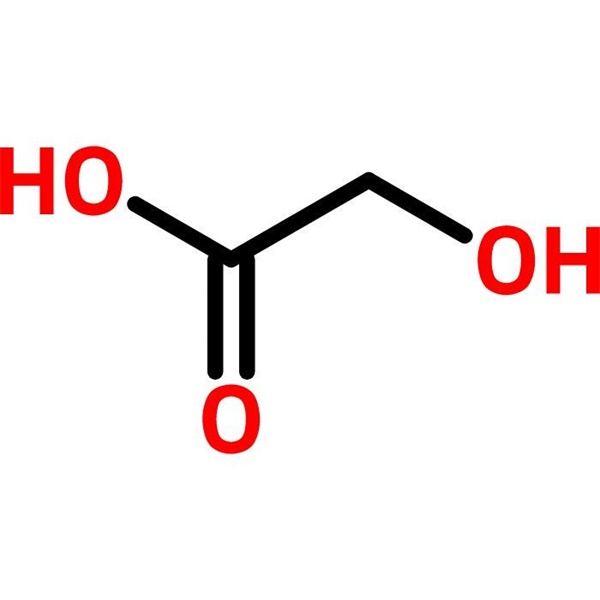Chemical Properties:
Package: Bottle, Aluminium foil bag, 25kg/Cardboard Drum, or according to customer's requirement. Storage Condition: Store in sealed containers at cool and dry place; Protect from light and moisture.Shanghai Ruifu Chemical Co., Ltd. is the leading manufacturer and supplier of Glycolic Acid (CAS: 79-14-1) with high quality, commercial production. We can provide Certificate of Analysis (COA), Safety Data Sheet (SDS), worldwide delivery, small and bulk quantities available, strong after-sale service. Welcome to order. Please contact: alvin@ruifuchem.com| Item | Specifications |
| Appearance | Colorless or White Crystal Powder |
| Purity / Analysis Method | >99.0% (Neutralization Titration) |
| Melting Point | 75.0~80.0℃ |
| Moisture (K.F) | <0.50% |
| Residue on Ignition | <0.05% |
| Water Insoluble | <0.01% |
| Color | <25APHA |
| Chloride (as Cl-) | <0.001% |
| Sulfate (as SO42-) | <0.01% |
| Heavy Metals (as Pb) | <10ppm |
| Iron (Fe) | <5ppm |
| Arsenic (As) | <2ppm |
| Sulfuric Acid Test | Confirm |
| Clarity Test | Confirm |
| Solubility in H2O | Almost Transparency |
| Infrared Spectrum | Conforms to Structure |
| Test Standard | Enterprise Standard |
| Usage | Cleaning Agent; Organic Synthesis; etc. |
Description:
Specifications:
Package & Storage:
| Chemical Name | Glycolic Acid |
| Synonyms | Hydroxyacetic Acid |
| CAS Number | 79-14-1 |
| CAT Number | RF-PI1722 |
| Stock Status | In Stock, Production Scale Up to Tons |
| Molecular Formula | C2H4O3 |
| Molecular Weight | 76.05 |
| Specific Gravity (20/20) | 1.27 |
| Refractive Index | n20/D 1.41 |
| Brand | Ruifu Chemical |
Advantages:
FAQ:
Application:
Glycolic Acid (CAS: 79-14-1) 1. Chemical Cleaning: 70% glycolic acid solution is mainly used as a cleaning agent. which can be used as a pipeline for air conditioning, boilers, and power plants. The main cleaning materials for condensers, heat exchangers, etc. 2. Biodegradable materials: It is widely used in the preparation of implanted sustained-release drug systems, implanted repair devices, bioabsorbable surgical sutures, artificial bone and organ materials, etc., which have very promising development prospects. Polylactic Acid and Polyglycolic Acid have become the focus of the development of new materials. 3. Bactericide: Because glycolic acid has a special structure of hydroxyl and carboxyl groups, it can form a hydrophilic chelate with metal cations through coordination bonds, so it has a significant inhibitory effect on the growth of iron oxidizing bacteria and can be used as a bactericide. It can also be used as inhibitor in a variety of ore flotation. 4. Daily chemical products: 99% glycolic acid is a good agent for removing dead skin and hairs. It can synthesize fruit acid, which is the raw material for anti-aging and whitening cosmetics, and can achieve the effects of moisturizing, moisturizing the skin and promoting epidermal renewal. Glycolic acid has a very small molecular weight. It can effectively penetrate skin pores and solve skin aging, wrinkles, dark spots, acne and other problems in a short period of time, so it is unanimously praised by the medical beauty industry. 5. Electroplating surface treatment: Glycolic Acid can also be used in the electroplating industry. Sodium glycolate and potassium salt can be used as electroplating additives, as well as green chemical raw materials for electroplating grinding, metal pickling, leather dyeing and tanning agents. Glycolic Acid is also a complexing agent for electroless nickel plating. It has the advantages of corrosion resistance, fast reaction, and good finish. It is the best raw material for improving the quality of electroless nickel plating. 6. Glycolic Acid can be used for dyeing and finishing wool fiber and cellulose fabric cross-linking coupling agent or cross-linking catalyst for carboxyl-containing fiber fabric in the textile industry; it can also be used as an adhesive, petroleum demulsifier, welding agent and coating ingredient And synthesize a variety of medicines, pesticides and chemical additives.


